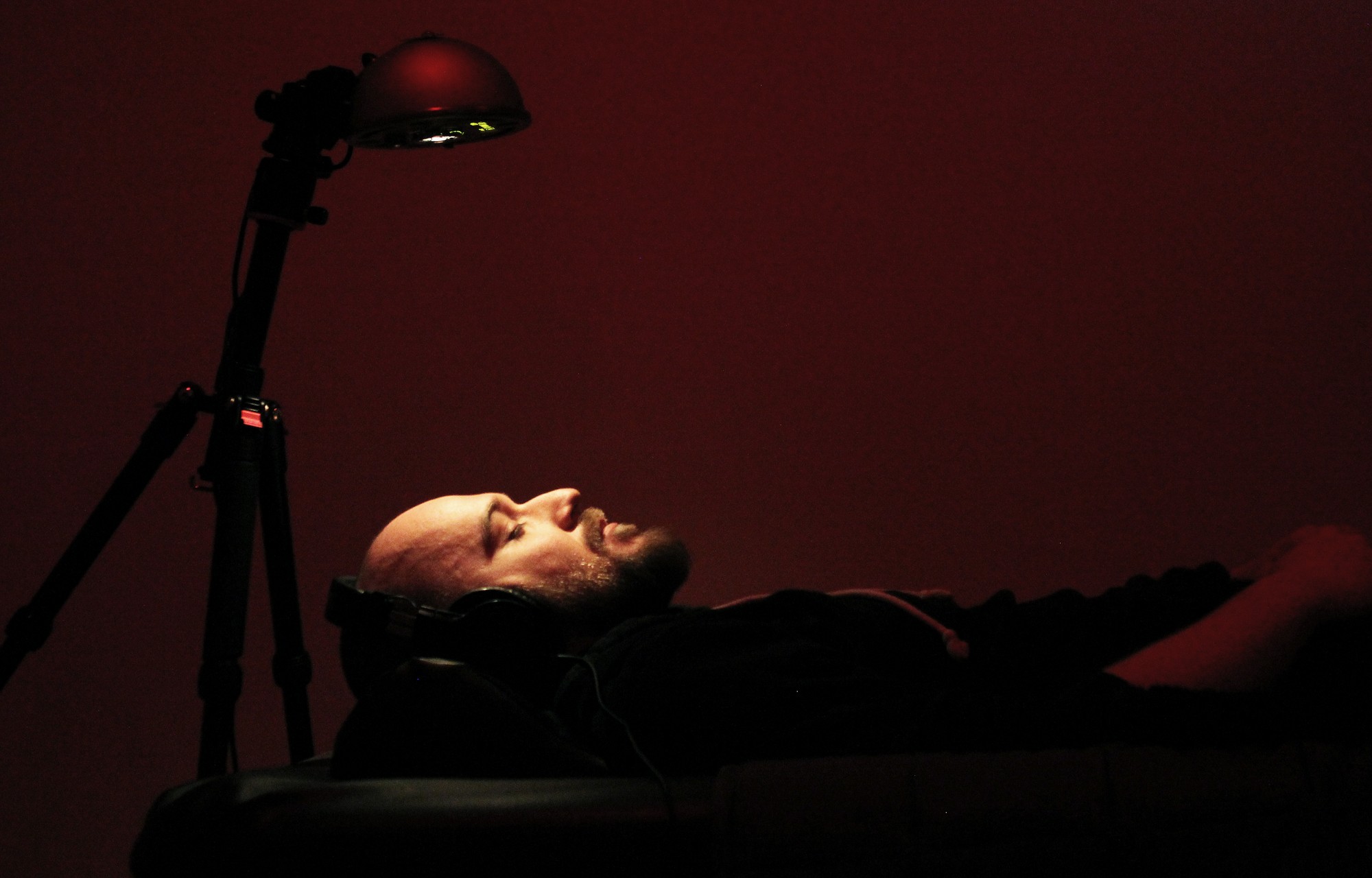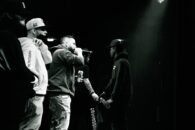What brings a college student to this place is the search for a holistic alternative to what they would normally get from a rave: full body sensations, psychedelic hallucinations, immersion into music, disconnection from student life and a deep connection with other people. All of these elements can be found here, only the deep connection is solely within yourself.
You arrive to your first session of pulse light therapy, not knowing what to expect, bringing nothing but an open mind. The business’ logo hangs outside of the owner’s house. Golden letters on a matte black sign read “Omni Aura.”
Shahbaz Mansoory, 46, founder of Omni Aura and expert percussionist specializing in Djembe and Conga, greets you with a smile. Originally from Montreal, Que., Mansoory lived in Mumbai, India, where he worked as a musician and music producer for 10 years – from 2006 to 2016. Mansoory then became deeply involved in meditation and pursued education in “holistic wellness.” What he learned he brought back, and he founded Omni Aura in 2019 to introduce a new, holistic alternative to rave culture in Ottawa.
Though raves are cancelled due to the pandemic, Omni Aura remains open. With social distancing measures in place and frequent sanitizing protocols due to COVID-19, Mansoory allows no more than three people inside at once.
The basement is quiet and smells of incense. It’s dark, lit with a dim, crimson red light. The red glare reveals friendly faces on spiritual statues around the room. The only thing you hear is the soft trickle of water coming from a small fountain at the front desk surrounded by crystals and business cards.
Through Mansoory’s experience in India searching for different approaches to meditation, he came across the Lucia light. He was first introduced to pulse light therapy by Amitabh Swetta, owner of 1000 petals and known for his work in introducing light therapy in India. Mansoory then brought a Lucia lamp to Canada and offers light therapy services in his home in Orleans.
The Lucia light is a meditative light machine created and developed in Austria by psychiatrist and psychologist Dr. Engelbert Winkler, medical neurologist and psychologist Dr. Dirk Proeckl, and engineer Jury Locker.
The Lucia light website describes the light’s purpose for humans, whom they call beings of light. “All of our cells communicate through light,” the website explains. This communication is just being confirmed now by molecular biologists. “The wide-spectrum of solid and flickering light enters the body through the closed eyes, travels into the central brain where the pineal gland is located and continues through the whole body.”
They explain that the light activates the entire cellular and energetic light system in human bodies, sending waves of energy, “that clear blocks, release pent up emotions and traumas and also release any other stagnant energy.”
Mansoory is the only person in Ottawa offering pulse light therapy as a meditation tool. “Omni Aura provides a clean, comfortable, friendly and safe healing environment for deep meditation,” Mansoory says. “The intention of meditation is the attempt to calm the mind so that one can access the pineal gland or the third eye. This process can take time. The pulse light therapy assists in activating your pineal gland more quickly. I found that what I could achieve in a 10-minute light session would normally take me about 40 to 50 minutes without.”
The ideal candidate for this light’s power is not only any individual looking to deepen their meditations but people that get benefits from rave culture such as being in a trance state, complete disconnection from the every day and full immersion in the present moment. “This is a drug-free, hangover-free, psychedelic-like experience that is enhanced with deep muscle relaxation and music,” Mansoory describes.
First, you lay on a hydro massage: a dry bed that uses water pressure to massage the area of your body that is in direct contact with the table, from your head to your heels. Then, you put headphones on. Mansoory, also known as his musician name “DrumBoodha,” plays original tracks he created made up of different tones, tempos, beats and waves. You can quickly recognize the Conga and Djembe in the melodies, setting the tempo for the visuals your mind will create. The Lucia lamp is turned toward your face, about six inches above your forehead. With your eyes closed, you are to remain still, focus on your breath and relax as you would during a meditation session. The light flickers over your closed eyes which causes geometrical illusions and colourful schemes, like old wall paper motifs, to appear in the… space.
The usual dark, empty space you see with your eyes closed opens up, like you are floating into a pitch black atmosphere. Three-dimensional patterns appear as the light flashes before your eyelids. While focusing on the artistic creations your brain is making from a single flashing white light, the patterns move around and change as new colours come into frame, accelerating and decelerating with the tempo of the music. Imagine a scene from a movie where someone just took magic mushrooms and the production team uses bright neon colours, spinning circles and textures moving, turning and changing size to represent the high. That’s what you see.
“Only you’re not on drugs. You are meditating. You are in a healthy, happy environment experiencing a higher state of consciousness and you will be able to drive home when this is done, go to work, go to class, be productive and creative,” Mansoory explains.
Similarly to rave culture, where music, environment, stimulation, psychedelics and music put people into a state of trance, pulse light therapy has all the same elements without the discomfort of packed crowds, busy music festivals, dangers of overdose, bad weather conditions, and abuse to your health with toxic substances like drugs and alcohol.
“Clients have reported improvement with focus, sleep, reduced stress, better mood and an overall feeling of well-being after deep relaxation,” Mansoory explains. “This is a completely drug-free, non-prescription, affordable, alternative solution to chemicals and pharmaceuticals without the negative side effects.”
Alexandre Le Voguer, graduate of the police foundations program at Algonquin College, experienced pulse light therapy at Omni Aura.
“I’m always open to trying new relaxation methods in general and this was one that I was curious about,” Le Voguer says. “So when the opportunity presented itself, I had to give it a try.”
Le Voguer went into his session with no expectations, only curiosity for this holistic practice he had never heard of before.
“Overall it was a really good experience,” Le Voguer says. “A little bizarre at first, but I quickly found myself easing up and drifting into a different mind space as I just watched this spectacle of colours and lights being naturally produced behind my eyelids.”
Though there are not many studies on pulse light therapy and red light therapy, mindfulness practices are becoming more mainstream in western culture. The Lucia light is not a medical treatment, it is a meditation tool.
“The intention is to support and implement a sense of mindfulness and peace in the surrounding community,” Mansoory says. “Our main goal is to help your mind and body connect, developing your own healthy and spiritual process.”
You can read about the Lucia light on their website and find out more about Omni Aura at www.omniaura.ca.



